IJCRR - 7(17), September, 2015
Pages: 52-58
Date of Publication: 11-Sep-2015
Print Article
Download XML Download PDF
ABO, RHESUS BLOOD GROUP AND ALLELE FREQUENCY IN AND AROUND RAIPUR (CHATTISGARH STATE), INDIA
Author: Shruti Shrivastava, Renuka Gahine, Vijay Kapse
Category: Healthcare
Abstract:Aim: ABO blood group system is shared by all human populations; but frequencies of distribution differ. Variation in distribution of ABO and Rhesus phenotype between ethnic and geographic population is a well documented fact. Blood groups are genetically determined and exhibit polymorphism in different populations. Present study was conducted with an aim to determine prevalence of ABO and Rhesus blood groups and allele frequency among people in and around Raipur. Subject and Method: Study conducted over a period of 2 1/2 years included 46,444 persons( recipients and donors ) attending blood bank of Dr. B R A M hospital associated with Pt JNM Medical College Raipur. Blood groups were determined by standard
methods. Calculations for allelic frequency were based on Hardy Weinberg equilibrium.
Result: The most prevalent blood group was B (35.42%) closely followed by group O (33.55%) and group A (22.17%). Least prevalent blood group was AB (8.17%) Rh D positive prevalence was 96.85% and 3.15% persons were Rh negative. Breakup of Rh negatives showed that 1.24% were group B, 1.00% were group O, 0.66% were group A and 0.20% were group AB. Allelic frequency calculations showed O allele to be most common. Conclusion: In present study blood group B was the commonest, closely followed by group O. More than 95% population is Rh positive. Distribution of ABO and Rh blood group is close to that seen in northern parts of India, Rajasthan, adjoining Pakistan, and Bangladesh.
Keywords: ABO, Rhesus, Blood groups, Allele frequency, Chhattisgarh
Full Text:
INTRODUCTION
Variation in distribution of ABO and Rhesus phenotype between ethnic and geographic population is a well documented fact. Blood groups are genetically determined and exhibit polymorphism in different populations. Blood group ABO was identified by Karl Landsteiner in 1900[1]. Blood group AB was identified 2 years later by des Castillo and Struli in 1902[2]. Since then a total of 30 blood group systems have been recognized by International Society of Blood Transfusion including Rhesus (Rh) system, which was identified by Landsteiner and Weiner in 1941[3,4]. But ABO and Rh blood grouping is still the most important test performed in Blood Banks to avoid mortality and morbidity [5]. Apart from the importance of ABO and Rh blood groups in transfusion practice, they are also important in organ transplantation, anthropological studies, and have medico legal importance [6, 7]. ABO blood group system is shared by all human populations; but frequencies of distribution differ. ABO blood group distribution studies are available from various parts of India and world. To the best of our knowledge there is no recent published study available on the ABO and Rh blood group distribution among general population in Chhattisgarh state. So with an aim to know the blood group distribution and blood group allele frequency among people in and around Raipur (Chhattisgarh state), and to compare the results with distribution among other populations, this study was conducted among blood donors and recipients in the blood bank of a tertiary care hospital of Raipur .
MATERIAL AND METHOD
The study was performed over a period of two and half years from January 2009 to June 2011 in the largest Blood Bank of Chhattisgarh state. The study group included 46,444 persons including blood donors and recipients. Donors were taken randomly (not patient directed). For grouping 2ml Blood samples were collected in EDTA vial. Grouping was carried out by standard tube technique. For grouping commercially available monoclonal anti sera anti A, Anti B, and anti AB manufactured by Tulip Diagnostics (P) Ltd and SPAN Diagnostics Ltd were used. All reagents were subjected to quality control test and had a minimum titre of 1: 256. For reverse grouping, known cell preparations of A, B, and O blood group cells, pooled from three different known donor samples were used. On each day of use, known cells for reverse grouping were prepared fresh and known samples were run as controls. Special care was taken to avoid repetition of persons by double checking each entry. RESULTS The study conducted over a period of 2 1/2 years from Jan 09 to June2011 in blood bank of Dr. B.R.A.M. Hospital Raipur involved 46,444 persons. Results are presented in Table 1. Among general population of Chhattisgarh Blood group B showed highest prevalence with 16452 (35.42%) persons. It was closely followed by group O with 15583(33.55%) persons. Group A and AB were in 10612 ( 22.17%) and 3797 (8.17)persons respectively. Inclusive of all ABO blood groups, Rh D positive prevalence was 96.05% (44,994). Least prevalent blood group was AB-ve with 0.20% prevalence.
Calculations for allelic frequency were based on Hardy Weinberg equilibrium law that says that at equilibrium (p + q + r) 2 = p2 + q2 + r2 + 2pq + 2rp + 2qr = 1, where p2 is the probability of IAI A and 2pr is the probability of IAi (thus probability of type A = p2 + 2pr),
q2 is the probability of IBIB and 2qr is the probability of IBi(thus probability of type B = q2 + 2qr),
r 2 is the probability of ii (thus probability of type O = r2 ), and 2pq is the probability of IAIB(thus probability of type AB = 2pq).
Preliminary estimates were calculated manually as:
p = 1 - √B+O, q = 1 - √A+O, r = √O (p, q, r denote allele frequencies and A, B, O denote observed frequencies of blood groups A, B and O.)
Assumptions for the Hardy–Weinberg equilibrium law are
- The organism under study is diploid,
- There is sexual reproduction ,
- Non overlapping generations,
- Random sampling study,
- Trait is determined by three alleles of a single gene namely A, B, and O,
- Co dominance of A and B and dominance of both over O.
Static allele frequencies in a population across generations assume that:-
- Migration is negligible
- Mutation can be ignored
- Random mating
- Population size is very large Calculation of allelic frequencies:-

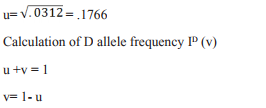
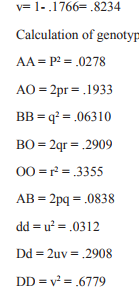
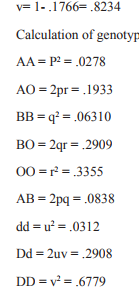
The calculated gene frequencies are .1716 for IA (P), .2512 for IB (q) and .5792 for IO. In population from Chhattisgarh O (r) recorded the maximum frequency followed by B (q), and A (p). The Chi Square test for Goodness to fit between the observed and expected phenotype in case of ABO blood group was .0077 and the result is not significant at p=≤0.05. In case of Rh (D) group the calculated frequency for I (D) (v) was .8234 and that for Id (v) was .1766. For statistical calculations and confirmation of manually calculated gene frequencies S2ABO estimator by Silva Square was used. S2 ABO estimator by Silva Square is a program to estimate the allele frequencies of the ABO blood group system, and perform a couple of statistical tests on the data, particularly to compare simple heuristic estimates of the allele frequencies, to show the EM algorithm in action, to obtain maximum likelihood (ML) estimates of the allele frequencies and to perform goodness-of-fit tests of the HardyWeinberg assumption.
DISCUSSION
The Present study on ABO and Rh prevalence among people in and around Raipur included 46,444 individuals and we observed predominance of blood group B and allele O. Precursor substance for ABO blood group is antigen H, present on the surface of membrane of red cells and most of the epithelial and endothelial cells. The A allele codes for an enzyme that adds an N-acetyl galactosamine to the H antigen. The B allele, which differs from the former by four amino acid changes, codes for an enzyme that adds a D-galactose. The O allele occurs most frequently in modern humans and carries a human-specific inactivating mutation which produces a nonfunctional enzyme, and thus the H antigen remains without further modification on the surface of the cells.[8] As ABO blood group system is of autosomal inheritance controlled by a single gene at chromosome 9q34 , the frequency of blood groups is not different in both sexes[9], so we have not divided study group on the basis of male and female. An individual has the same blood group throughout his life; therefore no categorization of donors according to age was done. However few reports are there that an individual’s blood group changes through addition or suppression of an antigen in malignancy or in autoimmune disease. [10] Results of ABO blood group distribution among people of Chhattisgarh were close to studies from Northern India, Rajasthan, neighboring Pakistan and Bangladesh with B group predominance but O group followed closely behind. We can say that in these areas B ≥ O>A>AB [Table-2]. State of Chhattisgarh is having a different population base as compared to rest of India with 31.76% of “Tribal population”[11]. A higher tribal population base is not causing much difference in distribution of blood groups as compared to northern parts of India. Studies from Kashmir and Southern part of India showed a pattern of O>B>A>AB[Table-2]. Agarwal A et al showed O blood group predominance from central part of India. Chattisgarh is also from central part of India and their findings are in variance with the present study[24]. This difference may be due to larger population base of present study. Behra Rajshre also showed blood group B predominance from central India[14]. Blood group A predominance has been shown by Naidu and Veeraju in Brahmin community, by Datta et al in Lodha tribes of West Bengal and by Vokendra and Devi among selective tribes of Arunachal Pradesh[25,26,27]. This difference in distribution of blood groups represents multiethnic and anthropologically different origins of population. Among countries surrounding India, A group predominance has been reported from Nepal and B group predominance from Pakistan and Bangladesh.[Table-2] Allele O was most common in present study followed by allele B and A. these findings are in concordance with Agarwal A et al [24]. When data across the world is compared blood group distribution frequencies for A, B, O and AB blood group vary among different parts of the world [Table-3]. Although blood group B is most common blood group in present study, allele B is least common allele among world population with only 22% prevalence. Blood group B has its highest frequency in northern India and central Asia. Comparison of results of present study with that of some other populations is shown in Table 3. Blood group O is the most common phenotype globally with parts of Africa and Australia showing highest frequency. Blood group A is most common in northern and central Europe. Several theories have been proposed as reason for this difference in distribution and one of them is evolutionary selection based on pathogen driven blood group antigen changes [34 ]. Distribution of Rh phenotype in present study is shown in Fig-1 and in different parts of India and Neighboring Countries in table-4. There are opposing schools of thought for irrelevance or association between blood groups and diseases. Association of blood group A with gastric cancer is already proven. Some newer studies are suggesting association between blood group O and hemorrhage of upper gastrointestinal tract [35], between incidence of endometrioses and A+ve blood group[36,37]. An association of blood group AB with severe Dengue disease with reverse secondary infections has been suggested[38]. There are suggestions that A and B antigens serve as co-receptors in P falciparum rosetting, and selective digestion of A antigen from the uninfected red blood cell surface totally abolishes the preference of the parasite to form rosetting with these red blood cells. Thus persons with blood group O have lesser chances of developing severe P falciparum malaria as compared to persons with other blood groups.[39,40] Other recently suggested associations are of breast cancer in females with blood group A[41] and of myocardial infarction with blood group B [42]. Association of blood group A with stomach cancer has been established again in recent studies while blood group O people present with a higher risk of development of peptic ulcer [43]. Narendra Kumar et al have stated that the expression of certain blood group antigens on the surface of cancer cells can be regarded as an end product of tumour progression that can be used as a useful prognostic and diagnostic preclinical markers.[44]
CONCLUSION
We conclude that blood group B is most common among people in and around Raipur, with blood group O following closely behind. A higher tribal population base is not causing much difference in distribution of blood groups as compared to northern parts of India. Present study was conducted in blood bank of largest tertiary referral centre of Chattisgarh, which receives patients and blood donors from all over the state , representing general population of Chattisgarh. So we can say that the present study represents blood group distribution frequency among general population of Chattisgarh. As this study included a large number of individuals data obtained from present study may serve as reference for other studies in Chattisgarh state . We suggest a large population base and inclusion of other blood group antigens for prevalence of blood group studies that would further aid in the planning for better management of Blood bank inventory and improvement of transfusion services. Further studies for evaluation of blood groups as a preclinical marker can also be undertaken.
ACKNOWLEDGEMENT
Authors acknowledge the immense help received from the scholars whose articles are cited and included in reference of this manuscript. The authors are also grateful to authors/ editors/ publishers of all those articles, journals and books from where the literature for this article has been reviewed and discussed.
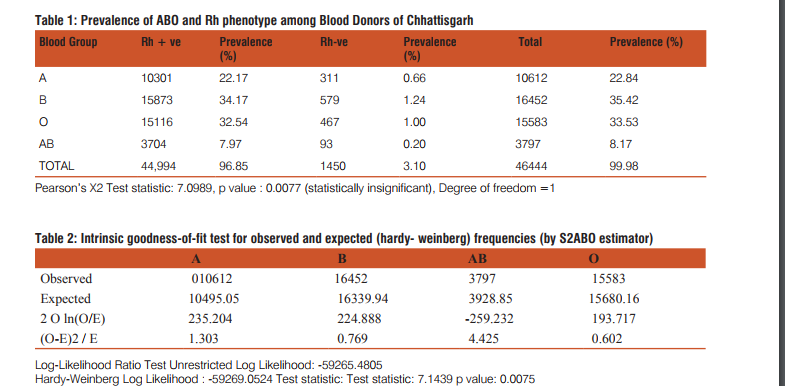

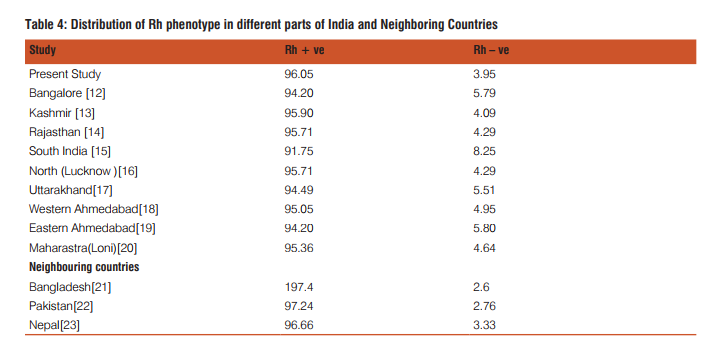
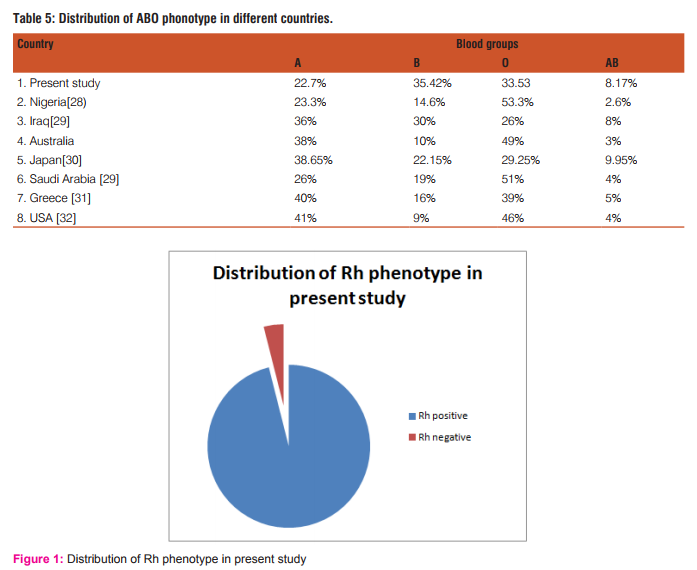
References:
1. Garraty G, Dzik W, Issitt PD, lublin DM, Reid ME, Zelinski T. Terminology for blood group antigens and genes - Historical origins and guidelines in the new millennium. Transfusion 2000, 40:477-89.
2. Von Decastello A, Sturli A Uber die Iso agglutinine in serum gesunder und kranker Menschen. Munchen Med Wochenschr 1902, 1090-95.
3. International society of blood transfusion ISBT “Table of blood group system” Oct’2008. http//ibgrl blood.co.uk, ISBT.
4. Landsteiner K, Weiner As studies on an agglutinogen (Rh) in human blood reacting with anti rhesus sera and with human isoantibodies. J Exp Med 1941; 74:309-20.
5. Honing CL, Bore JR. Transfusion associated fatalities; a review of bureau of biologic reports 1976-1978.Transfusion 1980; 20:653-61.
6. Poole J and Daniels G. Blood group antibodies and their significance in transfusion medicine. Transfusion Medicine Reviews 2007,21:58.
7. Yazer MH and Triulzi DJ. Immune hemolysis following ABO mismatched stem cell or solic organ transplantation. Current opinion in hematology 2007,14:664.
8. Narender Kumar, Akhil Kapoor, Ashok Kalwar, et al., “Allele Frequency of ABO Blood Group Antigen and the Risk of Esophageal Cancer,” BioMed Research International, vol. 2014.
9. The ABO and H blood group system. In text book of blood banking and transfusion medicine 2nd ed. Sally V. Rudman 2nd ed Saunders publication 2005, 73-74.
10. Matsushita S, Imamaru T, Mizuta T, Hand M. Acquired B antigen and poly agglutination in a patient with gastric cancer. Jpn J Surg 1983; 13:540-42.
11. Shrivastava M and Shrivastava N. Shodh Samiksha and Mulyankan (International research Journal). Dec 2009-Jan 2010, 11:11-12.
12. Periyavan S, Sangeetha SK, Marimuthu P, Manjunath BK, Seema DM. Distribution of ABO and Rhesus D blood groups in and around Bangalore. Asian J transfusion sciences 2010, 4:41.
13. Javed Ahmad Latoo, Naseer A Masoodi, Nisar Ahmad Bhat, G Q Khan, Showkat A Kadla. The ABO and Rh blood groups in Kashmiri population . Indian journal for the practicing Doctor 2006(05-06), 3.
14. Behra Rajshree, Joshi Yogi Raj. Distribution of ABO blood group and Rh(D) factor in western Rajasthan. National journal of medical research, 2013, 3:1, 73-75.
15. Das PK , Nair SC, Harris VK, Rose D, Mammen JJ ,Bose YN, etal. Distribution of ABO and Rh D blood groups among blood donors in a tertiary care centre in South India. Tropical Doctor 2001; 31, 47-48.
16. Tulika Chandra, Gupta Ashish. Frequency of ABO and Rhesus blood groups in blood donors. Asian J Transfusion sciences, 2012.V.6.1:52-53.
17. Parul Garg, Saloni Upadhyay, Sanjay Singh Chufal , Yuman Hasan, and Ishwer Tayal. Prevalance of ABO and Rhesus Blood Groups in Blood Donors: A Study from a Tertiary Care Teaching Hospital of Kumaon Region of Uttarakhand.J Clin Diagn Res. 2014 Dec; 8(12): FC16–FC19.
18. Patel Piyush A, Patel Sangeeta P, Shah Jigesh V, Oza Haren V. Frequency and distribution of blood groups in blood donors in western ahmedabad – a hospital based study.National J. Med. Res. 2012;2(2):207–210.
19. Wadhwa MK, Patel SM, Kothari DC, Pandey M, Patel DD. Distribution of ABO and Rhesus-D groups in Gujarat, India: a hospital based study. Indian J Ped Oncol.1998;19(4):137–41.
20. Giri P A, Yadav S, Parhar G S, Phalke DB. Frequency of ABO and Rhesus Blood Groups: A study from a rural tertiary care teaching hospital in india. Int J Biol Med Res.2011;2(4):988– 90.
21. Rayhana Sultana, Zaida Rahman, Asadul Mazid Helali, Rabeya Yousuf, Shyamoli Mustafa, Abdus Salam et al. Study of ABO and Rh-D blood groups among the common people of capital city of Bangladesh. Int J Pharm Pharm Sci, 213.V5.3: 814-16
22. Hammed A, Hussain W, Ahmed J, Rabbi F, Quersh J A.Prevalence of Phenotypres and Genes of ABO and Rhesus (Rh) blood groups in Faisalabad, Pakistan. Pak J Biol Sci. 2002,;5:722-724.
23. Giri P A, Yadav S, Parhar G S, Phalke DB. Frequency of ABO and Rhesus Blood Groups: A study from a rural tertiary care teaching hospital in india. Int J Biol Med Res.2011;2(4):988–90.
24. Agrawal a,Tiwari AK, Mehta N, Bhattacharya P, Wankhede R, Tulsiani S, Kamath S. ABO and Rh(D) distribution and gene frequency; the first multicentre study in India. Asian J Transfusion Sci 2014;8:121-5.
25. Naidu JM, Veeraju P. Blood groups among Brahmin and Kamma caste populations of coasta Andhra Pradesh. Am J phys anthropol 1982;58:197-9.
26. Datta UK, Mondal S, Mukherjee S. A study of the distribution of ABO and Rh(D) blood groups amongst Lodha tribe in Midnapore district of West Bengal. J Indian Med Assoc 1997;95:497-8, 506.
27. H. Vokendro and S. Devi. ABO Blood Group Frequency Distribution among the Tangsas of Arunachal Pradesh, India. Antrocom Online Journal of Anthropology 2012, vol. 8. no. 2.
28. ADEYEMO, Oyenike A and SOBOYEJO omolade B. Frequency distribution of ABO, Rh blood groups and blood genotypes among the cell biology and genetics students of University of Lagos, Nigeria. African journal of Biotechnology 2006,5:2062- 65.
29. Jaff S. Mohamad. ABO and Rhesus blood group distribution in Kurds. Journal of Blood Medicine 2010;1:143-46.
30. Australian Red Cross Society. All about blood. URL; www. donateblood.com.au/all-aboutblood/blood-types.
31. Yoshiko Fuguta, Masako Tanimura and Katuni Tanaka. Japanese journal of Human Genetics 1978; 23: 63-109.
32. T. Liatiaris, E Digkas S Poulilius , B Asimako poulos O pagonopoulou M. Simopoulou. Distribution of ABO and Rh blood groups in Greece: an update. International general of immunogenetics 2011; 38: 1-5.
33. Mollison PL, Engelfriet CP, Conteras M. The Rh blood group systems.Blood transfusion in clinical Medicine 10th ed. Oxford Blackwell scientific publications. 1997.
34. Storry JR, Olsson ML. The ABO blood group system revisited: a review and update.Immunohematology.2009;25(2):48–59.
35. Bayan K,Tuzun Y,Dursun Canorue F. Clarifying the relationship between ABO rhesus blood group antigens and upper gastro intestinal bleeding. Digestive diseasesandsciences 2009;54:1029
36 Matalliotakis I Chakmak H, Goumenou A, Sifakis S, Ziogos E and Arici A (2009) ABO and Rh blood groups distribution in patients with endometriosis Archives of Gynecology and obstetrics 2009; 280, 917.
37 Binder H, Flegel WA, Emran J, Muller A, Dittrich R Beckmann MW Zingsem J etal . Association of blood group A wih early onset ovarian hyperstimulation syndrome.Transfusion clinique et Biolgique 2008;15;395.
38 Siripen Kalayanarooj Robert V Gibbous , David Vaughn, Sharon Green Ananda Nisalak, Richard G Jarman, Mammen P Mammen Jr. Guey chuen Perug Oxford Journals > Journal of infectious diseases volume 195, Issue 7 Pg. 1014-1017.
39 Barragan, A., P.G. Kremsner, M. Wahlgren and J. Carlson, 2000. Blood Group A Antigen is a Coreceptor in Plasmodium falciparum Rosetting. Infection and immunity, 9: 2971-2975.
40 Tekeste, Z. and B. Petros, 2010. The ABO blood group and Plasmodium falciparum malaria in Awash, Metehara and Ziwayareas, Ethiopia. Malaria J., 9: 280.
41 Stamatakos M Kontzoglou K Safioleas P. Safioleas C Manti and Safioleas M (2009) Breast cancer incidence in Greek women in relation to ABO blood groups and Rh factor. International seminars in surgical oncology 2009.18.6
42 Nydeggar V.E. Wuilemin WA Julmy F, Meyer B J carrel T P (2003) Associatio of ABO histo blood group B allele with myocardial infarction. European Journal of immunogenetics 30, 201.
43 Edgren G, Hjalgrim H, Rostgaard K, Norda R, Wikman A, Melbye M, Nyrén O Risk of gastric cancer and peptic ulcers in relation to ABO blood type: a cohort study. Am J Epidemiol. 2010 Dec 1;172(11):1280-5.
|






 This work is licensed under a Creative Commons Attribution-NonCommercial 4.0 International License
This work is licensed under a Creative Commons Attribution-NonCommercial 4.0 International License